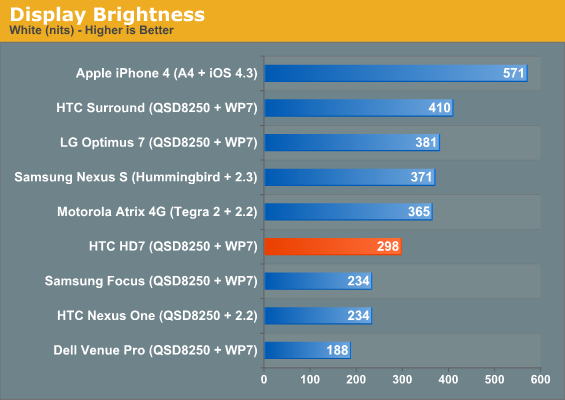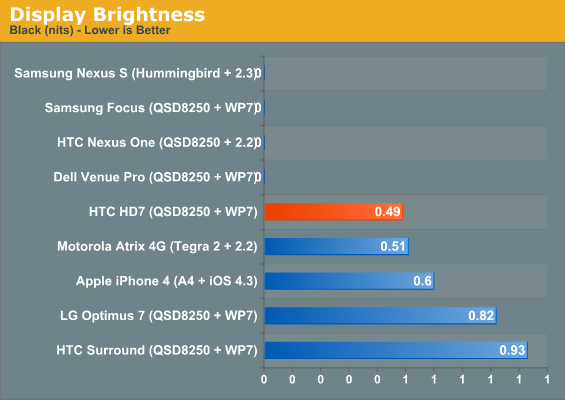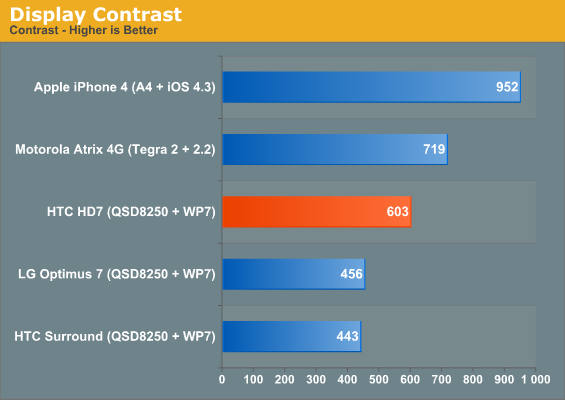HTC HD7: Now With NoDo
by Vivek Gowri on May 12, 2011 6:30 AM EST- Posted in
- Smartphones
- Windows Phone 7
- Snapdragon
- Mobile
- HTC HD7
The Trusty Old 4.3” WVGA
The above headline read “The Good Old 4.3” WVGA” until I realized that HTC’s 4.3” WVGA LCD panel is pretty mediocre at this point. It has size on its side, but brightness and contrast are middling at best. It’s not bad, but compared to the cream of the modern smartphone crop, it’s just not that competitive.



The upcoming HD7S for AT&T changes that, with a Super-LCD version of the same 4.3” display (the S stands for Super). We’ve seen pretty good performance out of S-LCD displays in the past, and assuming the HD7S continues that trend, it’ll have a decent display.
Thankfully, HTC is moving to S-LCD for the 4.3” qHD devices (Sensation and EVO 3D), but that brings up a larger question for Microsoft—with most of the high end Android devices moving to dual core processors and higher resolution qHD displays and Apple already with a high res screen and moving to a dual core SoC in the near future, when will Microsoft decide to take the next step to compete on the bleeding-edge hardware level?
1GHz Snapdragons and WVGA displays were high end in mid-2010. A year later, they’re still good enough for most smartphone users, but what about the high end market now? Most indications I’ve seen out of Microsoft seem like there will just be a bump to the 2nd generation 45nm Snapdragon chips for the second generation WP7 devices. Those will probably hit late this year, around the same time as the 5th generation iPhone and the next wave of dual-core Android phones (not to mention quad-core tablets), so WP7 handsets will still be lagging far behind the competition.
It’s a twofold problem. One is that Microsoft’s tight control of the system is creating the reverse effect of the fragmentation problems afflicting Android. While there’s a lot of software diversity in Android phones, there’s an equal amount of hardware diversity. With WP7, there’s zero software diversity, and correspondingly little hardware diversity as well. HTC has five different WP7 handsets on the market—one has a slide-out keyboard, one has a slide-out speaker, one has a marginally larger screen, but other than that, they’re all practically the same. The biggest differentiating factor from device to device is the type of screen it has; beyond that, all ten WP7 devices have nearly identical hardware.
Microsoft’s desire to keep a consistent experience across all Windows Phones is an admirable goal, but there’s only one way to do that and stay with the times technologically, which brings me to the second problem. They need to iterate faster, and not just on the software end (though I’ll address that on the next page). Microsoft is still playing catch up in the smartphone game, and matching Apple’s release schedule will not get them caught up. There either needs to be a large number of smaller iterations (Google-style, a new OS revision and new handsets every four months) or, really significant steps forward every 12 months. The former is where NoDo comes in.










44 Comments
View All Comments
TIGGAH - Thursday, May 12, 2011 - link
I think the battery life estimates are wrong. I own an HD2, HD7 and Focus - they all get comparable battery life. With the HD2 being a bit worse, the 7 in the middle and the Focus slightly better. Are the battery life figures presented obtained from the manufactures?Just curious.
Also I as always I have to gush about WP7. I support blackberry, android, ios and wp7 phones at my work. Hands down my user base who has WP7 are the most happy and require less support. Once we get a few critical apps that are iphone only available for WP7 we will dump almost all the iPhones.
Once mango comes out I think people will be even happier with WP7. Microsoft has truly created a gem here.
VivekGowri - Thursday, May 12, 2011 - link
The battery life figures were obtained in instrumented battery life testing. Overall, in day-to-day usage, the Focus and HD7 are very similar, but our battery life test takes a larger toll on AMOLED displays due to a higher percentage of white backgrounds in the pages we load. What I will say is that if you use the Venue Pro or Focus with the "light" WP7 theme, you will get awful, terrible, woeful battery life.I love WP7. I really do. It just needs some updating to get to feature parity with the iOS/Android crowd.
Ushio01 - Thursday, May 12, 2011 - link
Nokia uses 2 platforms S40 and S60, the major differences between these platforms are that the S60 smartphone platform has multitasking and customization while the S40 feature phone platform doesn't those are basically the only difference in software yet the WP7 phones i've used are at best equal to S40 on the software side.Penti - Thursday, May 12, 2011 - link
Actually technically S40 does multitasking since it's a Java ME device.And S60 is legacy.
Nokia has Symbian^3 and Maemo. Both modern OS's with a modern framework on top of them with Qt/Qt Mobility/QML and Gstreamer etc powering it. Modern frameworks and API for writing software. With Symbian still having the legacy frameworks for supporting S60-programs. So you can write POSIX C/C++ programs, Symbian C++ programs, Qt C++ programs, programs in scripting languages like Python, Java ME, Compiled web apps and so on. And you can compile and ship Qt with older S60 devices/apps. To just drop that platform makes no sense. It was the software platform driving MeeGo's mobile branch. Symbian was driving that platform into the wild and into stable code.
Microsoft is basically killing the future of Nokia all together, they sold over 100 million Symbian devices last year, and they kill Symbian and the investment in the software platform that was about to take over even in cheaper devices. Presently Symbian^3 devices only goes down to $309, but it can easily outplace older and cheaper S60 devices and go down as low as maybe $150 pretty soon, and would have sold well if they didn't kill it. Effectively killing all mobile phone OS development outside North America. To promote a platform that isn't as good (currently) or complete. Nokia already has all the modern bits there. In devices shipped already. They can also support stuff like Lotus Notes Traveler so you can have your notes mail in the phone. Which is at the moment technically impossible to do on WP7 phone even if IBM wanted to. Hoping that Nokia survives on S40 like Elop is, is just lunacy. S40 today is sub $150 devices. Not 400 dollar feature phones any more. If they themselves don't outplace the S40 devices someone else will and Nokia will drop their sales by hundreds of millions of devices, which is crazy, for a company that has production capabilities and plants themselves ruining billions in previous investments and tens of thousands of workers must go.
The mobile phone business of Nokia must bring in €40 billion euros to go around. Which of course Microsoft couldn't care less about. The future market of maybe 20 million a year WP7 devices don't make a dent in a company that size. They will earn less and has to destroy property and have it totally written off to have any money for the share holders. Microsoft 2 billion US or so deal will make them loose billions and billions of Euros. They could only keep a few thousand employees busy with building WP phones. The rest of the 60 000 is gonna have no future. They where however profitable before the Microsoft deal. Nokia can't survive on that chump change.
.NET CF before internet sockets, multitasking and alternatively native code isn't much use as a platform.
VivekGowri - Thursday, May 12, 2011 - link
I almost feel like this comment needs commercial breaks.I think what it comes down to is this - hanging onto Maemo and Symbian^3 was no longer a winning proposition in the smartphone game, while with Microsoft, Nokia has the chance to become the premier handset manufacturer for a platform with a lot of potential for both improvement and growth. Risk vs reward, at the base level.
FrederickL - Friday, May 13, 2011 - link
Very interesting article Vivek, most informative.
"I almost feel like this comment needs commercial breaks"
Actually what it needs is editing out all the malicious wishful thinking. I do not claim to know whether or not Nokia have made the right decision
- only time will tell. The point with Penti's post is that he/she *wants* the alliance to be a major fail. It will be interesting to see, in the event that it turns out to be a success, just how many of his/her words he/she will be able to eat and how much seasoning it will take to make them palatable.
"Nokia has the chance to become the premier handset manufacturer for a platform with a lot of potential for both improvement and growth. Risk vs reward, at the base level."
I agree wholeheartedly, Nokia have taken a big gamble and we will begin to see in the next year or so how it pans out. Personally I wish them well although I have no current intentions to move to WP7. I am very happy with my Desire Z!
Penti - Saturday, May 14, 2011 - link
Well even the N8 sold better then all the WP7 phones together, definitively they all together sold well over WP7. Only counting the latest Symbian^3.The wishful thinking is thinking Nokia could sell 100-150 million WP7 devices like next year or so. The market for all the manufacturers won't be that high by all account's even the overly optimistic ones. I do not wish WP7 to fail, but I still think it will for Nokia even if it's great for Microsoft and the users if they manage to sell 20-30 million devices a year again. As said you do realize there is no longer any mobile phone OS development outside of Canada and US? If they would have tired to bought them they couldn't have.
Obviously they had some challenges, but how are they suppose to meet those without any developers? They still turned a profit, so I think it was prematurely and possibly disastrous and harmful for the company, they are god damn fudding their own platform to death before they have a new one. Why behave like a broken company before you are one and stop building for the future.
In the event Nokia won't go under it will still turn into a company with 20 000 - 30 000 employees, and competitors would have gotten a hand on their manufacturing on fire sale outplacing Nokia in every segment. A success would be something like 1/3 of the current Symbian volumes, and that would be huge, and I don't think that is worthy a company like Nokia however I do not think they can't pull that off. And I wouldn't count that as a success, just like Motorola is just a abandoned shell of a company. I have no doubt Microsoft can be successful on the platform, it would do great if they can pull off all the promised features in Mango, however wishing for three platforms doesn't make it so. I don't think firing thousands of developers and closing down OS-business is a way to achieve that. Nokia is simply interesting for Microsoft because of Ovi Maps and Navteq. I wish Microsoft platforms the best, I simply just don't think it's good fit for Nokia as their exclusive platform. I think Nokia would need something that in a few years could sell 150-250 million devices a year, and I don't think WP has a chance do that, but I think their own had a small change to do so at least. Simply I don't see the benefit for the development to disappear. If they whore a failing company I could have seen a benefit to sell the OS/software and development like ones Symbian did in the 90's. Simply disregarding Qt and Nokia's recent effort just seems dishonest. Metro UI won't churn out hundreds of millions of new smart phones from Nokia. There's no reason to be overly optimistic about the move, they could put out some great phones, but I wouldn't translate that to commercial success. This is isn't desktop computers. There's still a good 5-6 months before Mango, and probably you won't see proper WP7 phones until next year. And in 2 years we won't see them sell 100 million smart phones like last year. Nothing malicious about that, it's just a totally different path they are taking. Selling a few millions devices in the US definitely won't save a global company.
They had the ST-E platform ready for Symbian and MeeGo, they had their hardware platform partnership which will just go to waste now when they have to start from scratch. They are also the only mayor manufacturer that will use one platform exclusively on smart-phones. So just closing down Symbian-shop rather then pursuing a multiplatform strategy don't make sense if you would like to be a big profitable company. It's not like S40 can take over for Symbian, neither should it. Nokia needed to get rid off all that, but now they are getting rid off their own company instead, which certainly don't give me confidence.
// Android Froyo, budgetphone user.
paul112 - Friday, May 13, 2011 - link
in this review it says there are 2 speakers, there isnt there's only 1 situated next to the camera, i was really dissapointed when i got home to hear the really crap sound quality output it has toodew111 - Friday, May 13, 2011 - link
Who's your source for that story? That's not the true story. The circle waiting icon in Windows 7 is nicknamed the donut, so no donuts means that there's less loading time...which there is in NoDo. Ridiculous pastry story killed.Affectionate-Bed-980 - Friday, May 13, 2011 - link
Because seriously, I'd like to see how the copy and paste works. It's not all about benches. Just like in motherboard and GPU reviews you spend the first 2-3 pages looking at the external appearance, analyzing the layout etc. You also look at the BIOS for motherboards before you just jump into benches.So seriously, I'd like to see some software stuff. This is like talking about Android 2.3 but just looking at benches only.